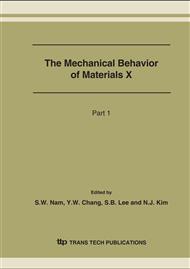p.545
p.549
p.553
p.557
p.561
p.565
p.569
p.573
p.577
Effect of Microstructural Inhomogeneity on Creep Response of Mg-Sn Alloys
Abstract:
The development of new creep resistant magnesium alloys has become a major issue in recent years. The alloys investigated in the present work are based on the binary system Mg-Sn. Sn as major alloying element was chosen due to its high solid solubility over a wide temperature range and due to the possible formation of Mg2Sn intermetallic precipitates with a high melting temperature of about 770°C. These characteristics suggest that a fairly large volume fraction of thermally stable Mg2Sn particles can be formed during solidification. This makes it possible that the Mg-Sn alloys can be developed as creep resistant magnesium alloys. In fact, previous investigations indicate that the Mg-Sn alloys have a comparable or even better creep property than AE42 alloy. The present work investigates the microstructure of Mg-Sn alloys with and without creep deformation using SEM and TEM technique. The effects of microstructural inhomogeneity on the creep response are presented. Based on the microstructural analysis, the mechanism responsible for improving the creep resistance will be discussed. It is shown that the grain boundary sliding is a dominant creep mechanism for the Mg-Sn binary alloy.
Info:
Periodical:
Pages:
561-564
Citation:
Online since:
August 2007
Keywords:
Price:
Сopyright:
© 2007 Trans Tech Publications Ltd. All Rights Reserved
Share:
Citation:


